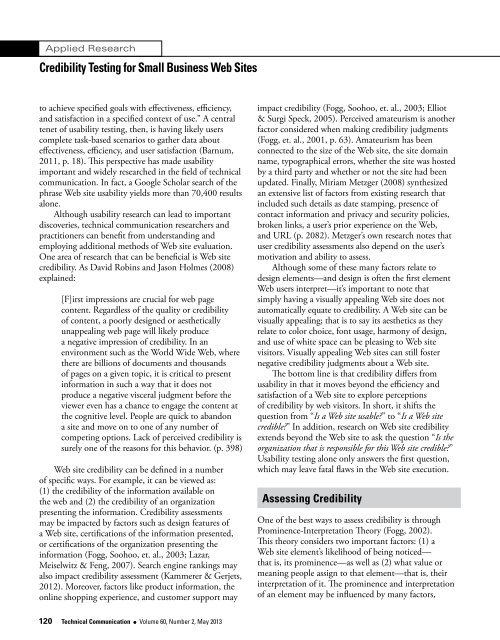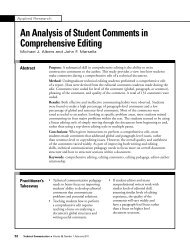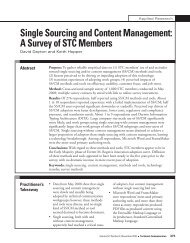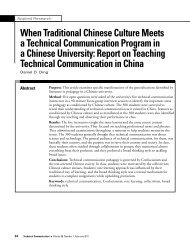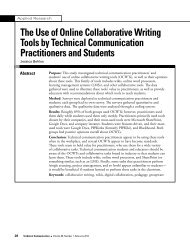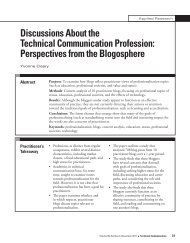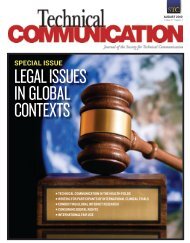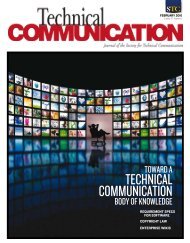Amateur Hour Credibility Testing for Small Business Web Sites
Credibility Testing for Small Business Web Sites - Technical ...
Credibility Testing for Small Business Web Sites - Technical ...
- No tags were found...
Create successful ePaper yourself
Turn your PDF publications into a flip-book with our unique Google optimized e-Paper software.
Applied Research<strong>Credibility</strong> <strong>Testing</strong> <strong>for</strong> <strong>Small</strong> <strong>Business</strong> <strong>Web</strong> <strong>Sites</strong>to achieve specified goals with effectiveness, efficiency,and satisfaction in a specified context of use.” A centraltenet of usability testing, then, is having likely userscomplete task-based scenarios to gather data abouteffectiveness, efficiency, and user satisfaction (Barnum,2011, p. 18). This perspective has made usabilityimportant and widely researched in the field of technicalcommunication. In fact, a Google Scholar search of thephrase <strong>Web</strong> site usability yields more than 70,400 resultsalone.Although usability research can lead to importantdiscoveries, technical communication researchers andpractitioners can benefit from understanding andemploying additional methods of <strong>Web</strong> site evaluation.One area of research that can be beneficial is <strong>Web</strong> sitecredibility. As David Robins and Jason Holmes (2008)explained:[F]irst impressions are crucial <strong>for</strong> web pagecontent. Regardless of the quality or credibilityof content, a poorly designed or aestheticallyunappealing web page will likely producea negative impression of credibility. In anenvironment such as the World Wide <strong>Web</strong>, wherethere are billions of documents and thousandsof pages on a given topic, it is critical to presentin<strong>for</strong>mation in such a way that it does notproduce a negative visceral judgment be<strong>for</strong>e theviewer even has a chance to engage the content atthe cognitive level. People are quick to abandona site and move on to one of any number ofcompeting options. Lack of perceived credibility issurely one of the reasons <strong>for</strong> this behavior. (p. 398)<strong>Web</strong> site credibility can be defined in a numberof specific ways. For example, it can be viewed as:(1) the credibility of the in<strong>for</strong>mation available onthe web and (2) the credibility of an organizationpresenting the in<strong>for</strong>mation. <strong>Credibility</strong> assessmentsmay be impacted by factors such as design features ofa <strong>Web</strong> site, certifications of the in<strong>for</strong>mation presented,or certifications of the organization presenting thein<strong>for</strong>mation (Fogg, Soohoo, et. al., 2003; Lazar,Meiselwitz & Feng, 2007). Search engine rankings mayalso impact credibility assessment (Kammerer & Gerjets,2012). Moreover, factors like product in<strong>for</strong>mation, theonline shopping experience, and customer support mayimpact credibility (Fogg, Soohoo, et. al., 2003; Elliot& Surgi Speck, 2005). Perceived amateurism is anotherfactor considered when making credibility judgments(Fogg, et. al., 2001, p. 63). <strong>Amateur</strong>ism has beenconnected to the size of the <strong>Web</strong> site, the site domainname, typographical errors, whether the site was hostedby a third party and whether or not the site had beenupdated. Finally, Miriam Metzger (2008) synthesizedan extensive list of factors from existing research thatincluded such details as date stamping, presence ofcontact in<strong>for</strong>mation and privacy and security policies,broken links, a user’s prior experience on the <strong>Web</strong>,and URL (p. 2082). Metzger’s own research notes thatuser credibility assessments also depend on the user’smotivation and ability to assess.Although some of these many factors relate todesign elements—and design is often the first element<strong>Web</strong> users interpret—it’s important to note thatsimply having a visually appealing <strong>Web</strong> site does notautomatically equate to credibility. A <strong>Web</strong> site can bevisually appealing; that is to say its aesthetics as theyrelate to color choice, font usage, harmony of design,and use of white space can be pleasing to <strong>Web</strong> sitevisitors. Visually appealing <strong>Web</strong> sites can still fosternegative credibility judgments about a <strong>Web</strong> site.The bottom line is that credibility differs fromusability in that it moves beyond the efficiency andsatisfaction of a <strong>Web</strong> site to explore perceptionsof credibility by web visitors. In short, it shifts thequestion from “Is a <strong>Web</strong> site usable?” to “Is a <strong>Web</strong> sitecredible?” In addition, research on <strong>Web</strong> site credibilityextends beyond the <strong>Web</strong> site to ask the question “Is theorganization that is responsible <strong>for</strong> this <strong>Web</strong> site credible?”Usability testing alone only answers the first question,which may leave fatal flaws in the <strong>Web</strong> site execution.Assessing <strong>Credibility</strong>One of the best ways to assess credibility is throughProminence-Interpretation Theory (Fogg, 2002).This theory considers two important factors: (1) a<strong>Web</strong> site element’s likelihood of being noticed—that is, its prominence—as well as (2) what value ormeaning people assign to that element—that is, theirinterpretation of it. The prominence and interpretationof an element may be influenced by many factors,120 Technical Communication l Volume 60, Number 2, May 2013


